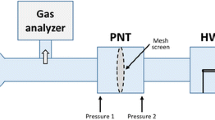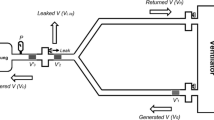Abstract
Back ground
Measurements with various flowmeters are affected by changes in gas mixture density. The Avance Carestation incorporates ventilator feedback controlled by a built-in flowmeter with a variable orifice sensor. We hypothesised that changes in the composition of delivered gas may cause changes in the delivered tidal volume by affecting the flow measurement unless appropriate corrections are made.
Methods
We used 100 % O2, 40 % O2 in N2 and 40 % O2 in N2O as carrier gases with/without sevoflurane and desflurane. We measured delivered tidal volume using the FlowAnalyzer™ PF 300 calibrated with the corresponding gas mixtures during volume control ventilation with 500-ml tidal volume using the Avance Carestation connected to a test lung.
Results
Change of carrier gas and addition of sevoflurane and desflurane significantly altered delivered tidal volume. Desflurane 6 % reduced delivered tidal volume by 7.6, 3.6 and 16 % of the pre-set volume at 100 % O2, 40 % O2 in N2 and 40 % O2 in N2O, respectively. Importantly, the Carestation panel indicator did not register these changes in measured expired tidal volume. Ratios of delivered tidal volume to 500 ml correlated inversely with the square root of the delivered gas density.
Conclusions
These results support our hypothesis and suggest that changing gas composition may alter delivered tidal volume of anesthesia machines with built-in ventilators that are feedback-controlled by uncorrected flowmeters due to changes in gas mixture density.

Similar content being viewed by others
References
Cotes JE, Chinn DJ, Miller MR. Lung function: physiology, measurement and application in medicine. 6th ed. Oxford: Blackwell Publishing Ltd.; 2006. p. 61–3.
Hess DR, Fink JB, Venkataraman ST, Kim IK, Myers TR, Tano BD. The history and physics of heliox. Respir Care. 2006;51(6):608–12.
Schena E, Massaroni C, Saccomandi P, Cecchini S. Flow measurement in mechanical ventilation: a review. Med Eng Phys. 2015. doi:10.1016/j.medengphy.2015.01.010.
Goto T, Saito H, Nakata Y, Uezono S, Ichinose F, Uchiyama M, Morita S. Effects of xenon on the performance of various respiratory flowmeters. Anesthesiology. 1999;90(2):555–63.
Habre W, Asztalos T, Sly PD, Petak F. Viscosity and density of common anaesthetic gases: implications for flow measurements. Br J Anaesth. 2001;87(4):602–7.
The Merck Index: an encyclopedia of chemicals, drugs, and biologicals. 14th ed. N.J., USA.: Merck Research Laboratories; 2006. Nitrous oxide, Oxygen; p. 6655, 6962.
Rika Nenpyo (Chronological Scientific Tables 2012). Tokyo, Japan: Maruzen Publishing; 2011. Density of gases; p. 388.
Elliott SE, Shore JH, Barnes CW, Lindauer J, Osborn JJ. Turbulent airflow meter for long-term monitoring in patient–ventilator circuits. J Appl Physiol Respir Environ Exerc Physiol. 1977;42(3):456–60.
Osborn JJ. A flowmeter for respiratory monitoring. Crit Care Med. 1978;6(5):349–51.
Specifications and Theory of Operation. GE Healthcare. Avance User's Reference Manual. Software Revision 6.X. p. 27.
Acknowledgments
This work was presented, in part, at the Annual Meeting of the Japanese Society of Anesthesiologists, Sapporo, May 2013. This work was financially supported by the department fund.
Conflict of interest
The authors have no conflict of interests to declare.
Author information
Authors and Affiliations
Corresponding author
About this article
Cite this article
Miyaji, T., Fukakura, Y., Usuda, Y. et al. Effects of gas composition on the delivered tidal volume of the Avance Carestation . J Anesth 29, 690–695 (2015). https://doi.org/10.1007/s00540-015-2018-8
Received:
Accepted:
Published:
Issue Date:
DOI: https://doi.org/10.1007/s00540-015-2018-8




